FRANK LESLIE'S
POPULAR MONTHLY.
Vol. LII. JULY, 1901 . No. 3.
THE GREAT LOG JAM
BY STEWART EDWARD WHITE.
THE STORY OF ONE OF THE MOST TERRIFIC BATTLES IN THE
HISTORY
OF AMERICAN INDUSTRY.
COPYRIGHT, 1901. BY FRANK LESLIE PUBLISHING HOUSE. ALL RIGHTS
RESERVED.
AFTER saw logs are cut and hauled to the banks of a river,
they rest until the spring floods. Then they are floated to the
mills.
To accomplish this apparently simple feat a large crew is required.
The men work twelve, sixteen, even eighteen hours a day in ice
water; sleep in temporary camps; and constantly expose themselves
to a hundred dangers. One of the greatest of these is encountered
while breaking jams, which, contrary to general belief, are of
common occurrence.
In a swift stream running through an accidental bed, great
masses of logs pile up with astonishing rapidity. A little obstruction,
a sudden narrowing or shoaling of the channel, an instant's check
of any kind, at once the advance guard tumbles together, the following
timbers grind down on the obstruction thus formed; the water banking
up quickly behind the temporary dam, presses the locked pieces
immovably together. Then it becomes a question of working with
peevy, axe or even dynamite, under the sheer face of timber, until
a sudden crack! warns the rioermen that the mass is about to vomit
down on them. They escape at the last moment over the logs floating
in the slack water below the jam. A single mis-step means death.
I have seen men save their lives by diving from before a breaking
roll-way into the icy river, and allowing themselves to be carried
down stream through the rush of waters.
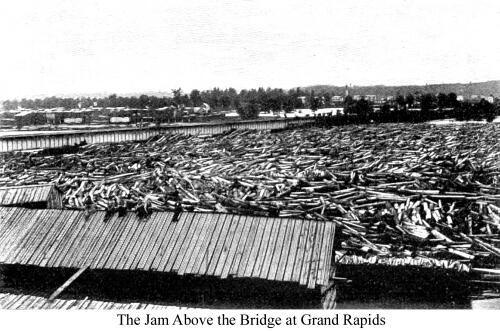 Ordinarily
it is expedient to break a jam as soon as possible. Once the river
begins to fall, the logs settle, and so press the more firmly
together. A very slight decrease in the volume of the water-will
lock the timber immovably. On the other hand, if the jam happens
to form between high banks, sooner or later the river will back
up sufficiently behind it to flow over it. Naturally, when this
happens, the logs on top are lifted, floated down, and precipitated
over the breast of the jam into the stream below, where they either
kill the men working at the breaking, or stick upright in the
river bottom as a further obstruction. The formation of a jam,
then, is a signal for feverish activity, and the man who is "driving"
the river never breathes freely until his logs are once more racing
down the current. Ordinarily
it is expedient to break a jam as soon as possible. Once the river
begins to fall, the logs settle, and so press the more firmly
together. A very slight decrease in the volume of the water-will
lock the timber immovably. On the other hand, if the jam happens
to form between high banks, sooner or later the river will back
up sufficiently behind it to flow over it. Naturally, when this
happens, the logs on top are lifted, floated down, and precipitated
over the breast of the jam into the stream below, where they either
kill the men working at the breaking, or stick upright in the
river bottom as a further obstruction. The formation of a jam,
then, is a signal for feverish activity, and the man who is "driving"
the river never breathes freely until his logs are once more racing
down the current.
Probably the biggest jam in the history of logging occurred
in the Grand River of Michigan in the summer of 1883. It involved
over one hundred and fifty million feet of logs. It is a little
difficult to convey an idea of an hundred and fifty million feet.
Such a mass would weigh, for instance, about thirty-seven million
tons. If piled evenly ten feet high in a river bed a hundred feet
wide, it would extend about ten miles. Singularly enough tremendous
day and night efforts were put forth, not to break the jam, but
to hold it. The men in charge knew that, once this tremendous
force should get beyond control, nothing short of a miracle would
prevent it from sweeping through everything and scattering abroad
over Lake Michigan. That would mean total loss, for salvage would
cost more than the lumber was worth. As a matter of fact, the
jam did get beyond control, and such a miracle did manifest itself.
The way of it was this:—
The first intimation outsiders received of the possibility of
danger came to them on June 26th. Three of the pile-driver men
in the employ of the company which had contracted to do the driving,
asked for two days vacation in order that they might take in Barnum's
circus at Muskegon.
"Can't let you off, boys," said the bookkeeper in
reply.
At the refusal the men grumbled somewhat and loudly considered
the advisability of going anyway. One of the company's officers
here interposed.
"We need you, boys, every one of you," said he, "and
if its worth anything to you to give up your holiday, I guess
the company will make it right. We're going to have all Grand
River down on us in no time."
That evening a tug took the men back to the boom, where, early
the next morning, they and their companions began a three weeks'
struggle.
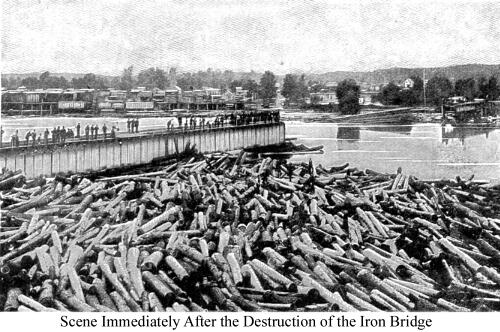 The company's
booms, or enclosures, contained about fifty millions of pine logs.
The enclosures were made of piles driven upright in the river
bottom, close together, and bound at the top by timbers bolted
strongly to either side. The main boom occupied half the channel
for a distance of two and one-half miles, and was supplemented
at the upper end by a floating swing 150 feet long, entirely closing
the river. This swing was operated by means of a winch and an
endless chain, exactly on the principle of a Harlem clothes-line
between two houses. In the narrow strip, so divided off, the logs
of all the sawmills of Nortonville, Spring Lake, Ferrysburg and
Grand Haven awaited sorting and distribution. Besides this, above
the main boom various temporary booms had been put in to accommodate
the extra amount of timber which an immediately preceding dry
season had accumulated. Immediately below was Lake Michigan and
total loss. The company's
booms, or enclosures, contained about fifty millions of pine logs.
The enclosures were made of piles driven upright in the river
bottom, close together, and bound at the top by timbers bolted
strongly to either side. The main boom occupied half the channel
for a distance of two and one-half miles, and was supplemented
at the upper end by a floating swing 150 feet long, entirely closing
the river. This swing was operated by means of a winch and an
endless chain, exactly on the principle of a Harlem clothes-line
between two houses. In the narrow strip, so divided off, the logs
of all the sawmills of Nortonville, Spring Lake, Ferrysburg and
Grand Haven awaited sorting and distribution. Besides this, above
the main boom various temporary booms had been put in to accommodate
the extra amount of timber which an immediately preceding dry
season had accumulated. Immediately below was Lake Michigan and
total loss.
When the three men reached their driver, they found that the
river had already swelled greatly in volume. Heavy rains were
partly accountable; but cloud-burst floods from Crockery Creek
district, above Grand Rapids, had rolled the streams to freshet
volume. A man stood all night on the swing, reporting at intervals
the progress of the water as it crept up the piles. By morning
it was very near the top. Men were at once set to raising the
height of the boom by tying logs firmly to the bolted timbers.
At other places the pile drivers drove strengthening buttresses
here and there where weak spots showed. Still other men stretched
from the boom piles to the shore, strong cables across the field
of logs, in order that the swift current might not jam them all
at the down-stream end of the enclosure. The cables were borrowed
of a barge company, and were of fifteen-inch manila rope.
So, although the water was boiling through at mill-race speed,
affairs were going well. The logs bound to the bolted timbers
would prevent the saw logs from jumping or flowing over the top
of the boom; the buttresses would keep them from breaking out
through the piles, and the cables would hold them, in sections,
from too great pressure below.
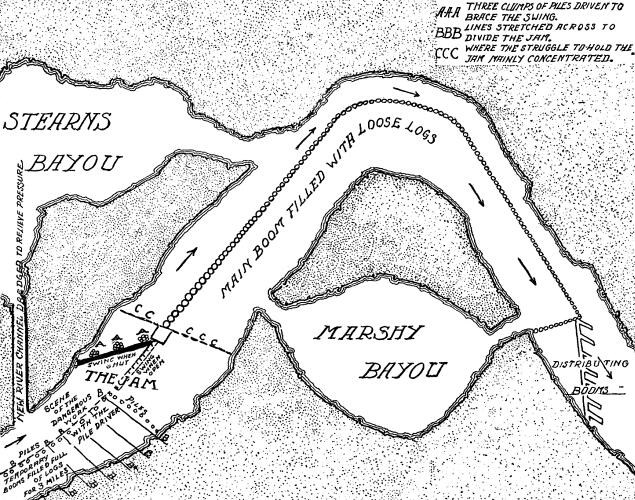
While this comforting conclusion was being reached at Grand
Haven, the Grand Rapids booms had broken, and one hundred million
feet of logs had rushed down stream to jam at the Detroit &
Milwaukee railroad bridge near Grand Rapids. Suddenly the affair
had become serious.
The D. & M. bridge, fortunately, was a new structure built
entirely of iron. Should it be carried out, however, nothing could
prevent the jam from sweeping away the other and lighter structures
down stream. Then it was a clear race from Grand Haven. 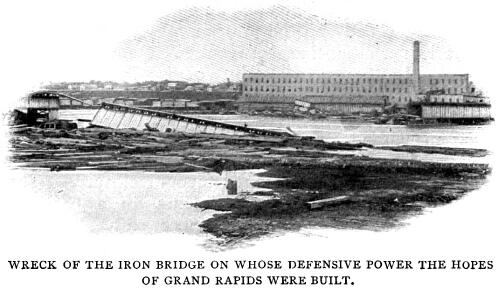 No one was sanguine
enough to imagine for a moment that the wooden defenses at Grand
Haven would oppose even a momentary barrier to the shock. The
result would be that all the hundred and fifty million feet of
the combined booms would sweep out into Lake Michigan, there to
be irretrievably lost. No one was sanguine
enough to imagine for a moment that the wooden defenses at Grand
Haven would oppose even a momentary barrier to the shock. The
result would be that all the hundred and fifty million feet of
the combined booms would sweep out into Lake Michigan, there to
be irretrievably lost.
The blow to the State's prosperity can hardly be estimated.
Besides a loss of some millions of dollars' worth of sawed lumber—which
would mean the failure, not only of many of the mill companies,
but also of thebankers holding their paper, and so of firms in
other lines of business—thousands of men would be thrown
out of employment; and, what was quite as serious, the destruction
of the bridges would mean the total severance of all railroad
communication between eastern and western Michigan. For a season,
industry of every description would be practically paralyzed.
The most strenuous efforts, then, were concentrated on the
new iron bridge. It was a massive structure, each of whose bents
weighed over a hundred tons. Braces of oak beams were at once
slanted where they would do the most good; chains strengthened
the weaker spots, and on top and all about ton after ton of railroad
iron held the whole immovably. It did not seem possible that any
force could stir such a mass.
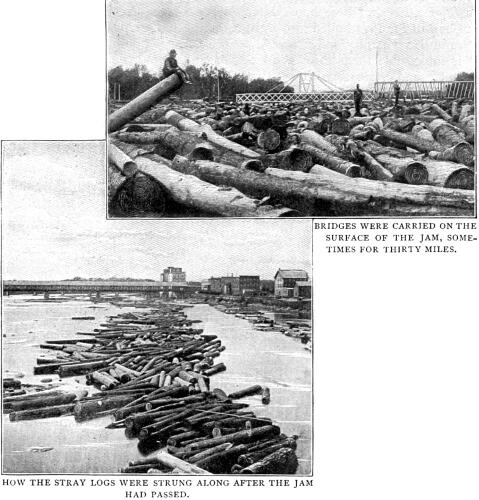 The jam extended
up river for over three miles, but fortunately floated. If it
had jammed to the bottom of the river, the water would have backed
up behind it as behind a dam; but now, luckily, the river had
a clear channel below the log's and the bridge. A slight fall
of the stream would suffice to lock the affair beyond the possibility
of accident. This fall, of a few inches only, actually occurred.
As the local paper jubilantly expressed it: "It's a hundred
dollars to an old hat she holds." The jam extended
up river for over three miles, but fortunately floated. If it
had jammed to the bottom of the river, the water would have backed
up behind it as behind a dam; but now, luckily, the river had
a clear channel below the log's and the bridge. A slight fall
of the stream would suffice to lock the affair beyond the possibility
of accident. This fall, of a few inches only, actually occurred.
As the local paper jubilantly expressed it: "It's a hundred
dollars to an old hat she holds."
Then, without the slightest warning, in seven minutes, the
jam gathered its might and carried away the elaborate defenses
as though they had been made of straw. Old man Jinby rode frantically
into Grand Rapids, like a second Paul Revere, screaming out that
the flood had broken loose. The other railroad bridges with the
exception of the Lake Shore, did not even offer a check. Five
hours later about half of the logs boiled into sight at Grand
Haven, fifty miles away.
It is impossible to describe the excitement and consternation
that reigned in Grand Rapids as the rushing timbers shot down
the current past the city. No old-established country could ever
understand it. Destruction threatened not only men's fortunes,
but their very life-work in building up a community. As the heavy
iron bridges one after the other crumpled up like matchwood and
were borne out of sight down stream on the very top of the jam,
no one for a moment entertained the hope that anything could stop
the rush this side of Lake Michigan.
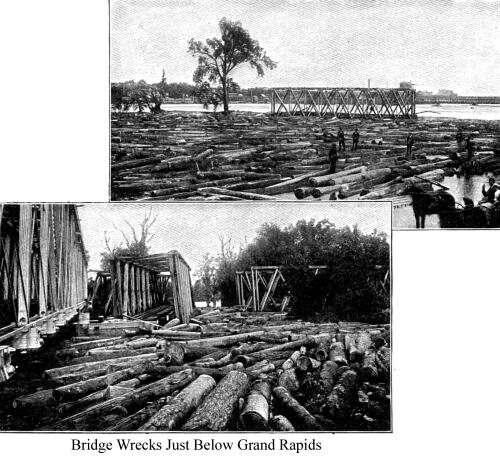 The first period
of security at Grand Haven had been of but short duration. All
that day and the following night the water had steadily risen
at the rate of an inch an hour. Soon it became evident that the
boom piles would never suffice to hold the enormous pressure when
once the full force of the freshet should bear on them. Especially
was this true of the temporary booms up stream. In order to hold
the logs from pressing against the main boom it became necessary
to shut the swing across the river. Before doing so, however,
the pile-driver started to drive three clumps of piles in the
opening, against which the swing, when shut, should rest. The first period
of security at Grand Haven had been of but short duration. All
that day and the following night the water had steadily risen
at the rate of an inch an hour. Soon it became evident that the
boom piles would never suffice to hold the enormous pressure when
once the full force of the freshet should bear on them. Especially
was this true of the temporary booms up stream. In order to hold
the logs from pressing against the main boom it became necessary
to shut the swing across the river. Before doing so, however,
the pile-driver started to drive three clumps of piles in the
opening, against which the swing, when shut, should rest.
Two of the clumps had been driven, and bound together by cables.
The third was in the process, when, with a crack and a roar, the
upper booms, giving way, projected their logs upon the opening
and the driver. Fortunately, the man in charge of the swing did
not lose his head. He succeeded in starting the long arm; the
logs, rushing in back of it, hurried it shut, jammed, and heaped
up in a formidable tangle behind the barrier.
The huge driver was lifted bodily in the air and deposited
with a crash half on the bank and half in the water.
For the moment all was safe. But the pressure had begun. Behind
the swing the logs were banked solidly to the bottom of the river,
and behind them the water gathered power every instant. Already
the main boom was feeling it. The great fifteen-inch cables tightened
slowly but mightily; some of the piles began to groan; here and
there a log up-ended across the level.
Now for four days and nights ensued a grim struggle for supremacy
that has probably never been equalled in industrial history. Twenty
million tons of logs and a river of water pushed steadily and
relentlessly; seventy-five men threw before them the ingenious
obstructions invented by determination and desperation. The pile-driver
worked day and night placing clumps, each of sixteen piles, bound
to solidity by chains, and so arranged in angles and slants as
to direct the enormous pressure toward either bank. Another drove
similar clumps here, there and everywhere that need arose. Men
stretched hawsers. Others did nothing but watch for the weakening
places. The groaning and creaking of the mass was said to be especially
terrifying—it must have been so to the devoted band who worked
without sleep under the frowning brow of destruction.
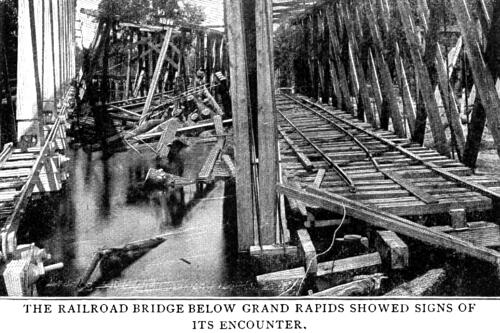 Not an instant
of those eighty-four hours was wasted. By the most tremendous
exertions the men seemed just able to keep even. It appeared that
a breathing spell would bring the deluge. Piles quivered, bent
slowly outward—at once, immediately before the logs behind
could stir, the driver must do its work. At night it was the worst.
No man could tell, while bracing one spot, how soon another might
give way to let loose his destruction. The water rose steadily;
the logs grew more and more restive, the defenses weaker and more
inadequate. Spectators marveled how the jam held, yet hold it
did, and without rest the dogged little insects under its face
toiled to gain an inch on the waters. Not an instant
of those eighty-four hours was wasted. By the most tremendous
exertions the men seemed just able to keep even. It appeared that
a breathing spell would bring the deluge. Piles quivered, bent
slowly outward—at once, immediately before the logs behind
could stir, the driver must do its work. At night it was the worst.
No man could tell, while bracing one spot, how soon another might
give way to let loose his destruction. The water rose steadily;
the logs grew more and more restive, the defenses weaker and more
inadequate. Spectators marveled how the jam held, yet hold it
did, and without rest the dogged little insects under its face
toiled to gain an inch on the waters.
So tremendous was the pressure at this time, that here and
there over the surface of the jam single logs could be seen popping
suddenly into the air, propelled as an apple seed is projected
from between a boy's thumb and forefinger. Some of the fifteen-inch
manila ropes stretched to the shore parted. One, which passed
once around an oak tree before reaching its shore anchorage, actually
buried itself out of sight in the hard wood! Bunches of piles
bent, twisted or were cut sheer off as though they had been nothing
but shocks of Indian corn. The current was so swift that the tugs
could not hold the drivers against it; and, as a consequence,
before commencing operations, especial mooring piles had to be
driven.
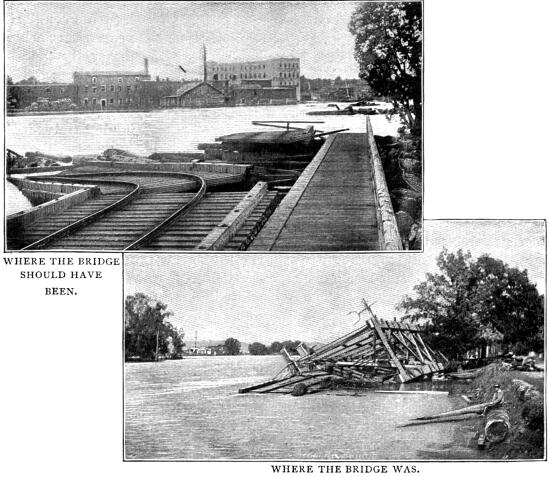 The excitement
was intense. Men who have served in the war tell me that the intoxication
of battle was nothing to it. In this combined the elements of
desperation and the spirit of the American pioneer bent on victory. The excitement
was intense. Men who have served in the war tell me that the intoxication
of battle was nothing to it. In this combined the elements of
desperation and the spirit of the American pioneer bent on victory.
The crew worked marvels. Few of them thought for an instant
of quitting. Once, after two nights without sleep, they began
to grumble a little. John Walsh, who had charge of No. 4 driver,
did not make the mistake of commenting or of raising objections.
"Boys," said he, irrelevently. "Let's have a
smoke."
So they sat down on the logs, while every moment cried out
for its labor, and for ten minutes puffed tobacco into the air.
"Now," said John, knocking the ashes from his pipe,
"come on and let's get something done!"
They responded to a man. It was the consummate art of leadership.
John Walsh wore a hook in place of one hand, but he was a wonder
for all that. His resourcefulness, courage and unbending firmness
had much to do with winning the battle. He was there for one thing—to
drive piles in the right places—and nothing could turn him
from his purpose. If a man was not actually working, he had no
business on the No. 4 driver, even though he might happen to be
one of the owners. One intruder refusing to leave quickly enough,
John promptly knocked him overboard into the shallow water between
the driver and the bank. Then as the fellow did not rise, John
fished for him in the most matter of fact manner with his iron
hook, threw him on the bank, unconscious, and went on driving
piles!
Another time, the jam broke suddenly just as John had a pile
in the carrier ready to hammer into place. The driver was picked
up bodily and carried some distance. The crew were pretty well
frightened, but the instant the craft came to a standstill, Walsh
cut loose the hammer and drove that pile. He had placed it in
the carrier for the purpose, and he was going to finish the job
if he were carried to Jericho!
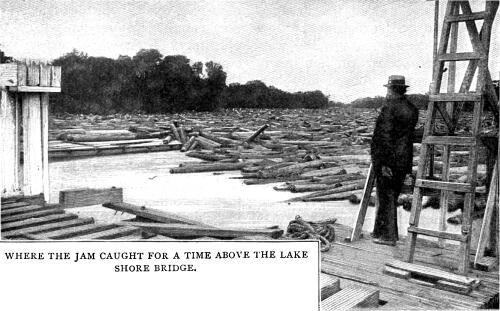 At this point
the men in charge originated one of those daring and original
plans which take their conception peculiarly in the American genius.
As the reader can see, the main difficulty lay in that the flood
was denied an outlet because of the logs jammed to its very bed.
Already, although the pressure was but slightly relieved by it,
the river had begun to spread laterally, thus carrying many of
the upper logs past the jam to the lake. The plan was to dig
a new channel for the river around the jam! Think of the magnificence
of the conception! At this point
the men in charge originated one of those daring and original
plans which take their conception peculiarly in the American genius.
As the reader can see, the main difficulty lay in that the flood
was denied an outlet because of the logs jammed to its very bed.
Already, although the pressure was but slightly relieved by it,
the river had begun to spread laterally, thus carrying many of
the upper logs past the jam to the lake. The plan was to dig
a new channel for the river around the jam! Think of the magnificence
of the conception!
A dredge was at once floated down from Grand Rapids. So swift
was the current that when the tug which accompanied and guided
the dredge, accidentally turned broadside to the channel for a
single instant, she was at once thrown so far on her beam ends
that the water poured into her main hatch. The dredge finally
got to work. In two days she had completed above the swing a new
channel some thirty-five feet wide. A great part of the river
immediately began to flow in this new bed; the pressure was relieved,
and so the danger point was passed for the moment.
Now ensued the breathing space, during which the Grand Rapids
logs hung at the iron bridge near that city. For some reason,
in spite of the local confidence above, Grand Haven never doubted
for a moment that the bridge would go eventually. Defenses were
strengthened. After a time, since nothing happened, it was resolved
to clear another channel through the jam.
To accomplish this men had to venture under the very breast
of it, to pry at the key logs until a portion of the face started,
and then in some manner to escape out of danger. While engaged
in this work, news arrived from Lowell and Plainfield, above Grand
Rapids, that the waters were again rising. It became necessary
at once to close the opening already made in order that the logs
might not break through it to the lake. To do so the driver had
to creep up into the very jaws of death. The tug captain refused
to tow the craft to her station.
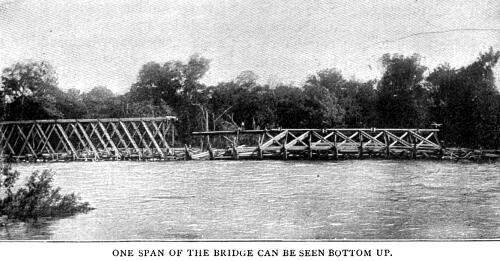 "It isn't
safe!" he expostulated. "It isn't
safe!" he expostulated.
"You get right off this tug!" cried the owner. "Go
over to the middle of that ten-acre lot and lie down on your face!
See if you'll feel safe there! Here, Jim, you take this tug."
A long line was made fast to the stern of the driver and tied
to a tree out of danger around a down-stream bend. As the craft
crept up between and under the threatening timbers, men paid out
this line, so that always they retained connection with a point
of safety. In case of necessity they could let go forward, drop
down with the current past the bend, and swing themselves out
of peril with the stern line. The tug would have to escape as
best it could.
As has been stated, the piles were driven in bunches of sixteen,
bound together by chains. The clumps were further connected by
a system of boom logs and ropes to interpose a continuous barrier.
The driver placed and bound the clumps, the tug attended to the
rest.
Shortly before venturing on this hazardous undertaking, they
received word from Grand Rapids that the bridge had gone, and
that the logs were on their way down the river. At this the rivermen
gave up hope. Many of them ceased their exertions. The Government
driver, which had been placing five extra booms at intervals down
stream, unmoored and quit. The case appeared quite hopeless. If
Grand Rapids could not hold a hundred millions with iron defenses,
Grand Haven could certainly do nothing against them with wooden!
The mere impact would suffice to jar them loose.
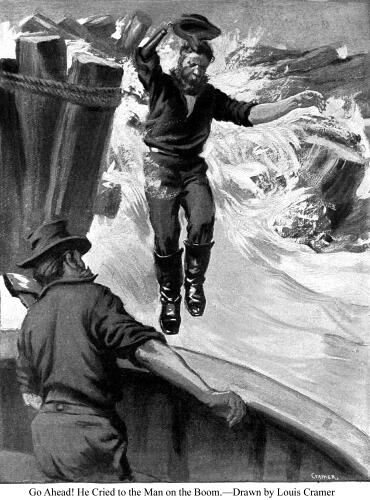 "That settles
my fifty thousand dollar house!" said one lumberman. "Twenty
dollars a month is good enough for me now." "That settles
my fifty thousand dollar house!" said one lumberman. "Twenty
dollars a month is good enough for me now."
One firm alone refused to yield. They were the owners of driver
No. 4, the employers of John Walsh, and had retained the generalship
during the long battle. A last stand was offered.
"Boys," said the two members of this firm, "if
she starts to go, save yourselves the best way you can. Never
mind the driver, stay on top!"
And so the tug and the driver crept slowly up the boiling water
under the jam.
A pile was placed in the carriage, the hammer descended. At
once logs commenced to shoot out of the water end foremost all
around them. The pile had been driven into the foot of the jam,
so loosening timbers at the bottom of the river. Luckily none
of them hit either of the boats squarely, or the craft would have
been stoved in and sunk. The fault of position was remedied, and
the work begun.
Four times the jam quivered. Four times it paused again on
the brink of discharge.
"One more'll hold her!" said Walsh, anxiously.
The pile was placed. Without delay the heavy chains were thrown
around the winch, and the steam power began to draw the clump
together. On the other side of the little channel the tug lay
moored fore and aft. John Walsh stood on the boom coolly tying
the last cumbersome knot of the system of defense. Clark Deremo,
all alert, grasped the spokes of the wheel. In the engine room,
Norris, his hand on the throttle, stood ready to throw her wide
open at the signal. A man at either end watched the owner's upraised
hand, prepared to cut the mooring lines when it should descend.
"Look out, John," said the owner, quietly, "she's
getting ready."
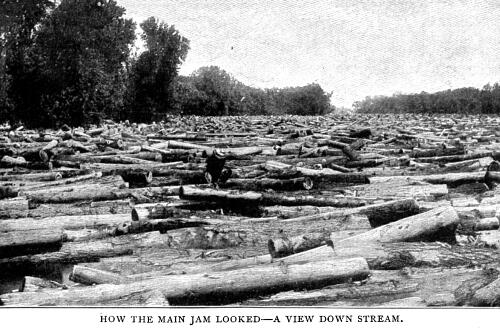 The man addressed
folded the knot over without reply. The man addressed
folded the knot over without reply.
Up-stream the jam creaked, groaned, settled deliberately forward,
cutting a clump of piles like straw.
"She's coming!" warned the owner.
"Give me every second you can," replied Walsh, without
looking up.
He was just making the last turns.
The mass toppled slowly, fell into the swift current and leaped
with a roar. The man in the waist of the tug watched with cat-like
attention.
"Jump aboard!" he cried to the man on the boom, and
his raised hand descended at last.
With the motion the two axes severed the mooring lines, the
wheel whirled, the little craft shot from its leash like a hound.
And so fine had they cut it that the first logs smashed their
stern rail! But the opening was closed.
The driver had escaped around the bend, as planned. If either
craft had been fairly caught, it would have been overwhelmed.
Subsequently Walsh and his brave crew ventured in to strengthen
some neglected spots. They took the places on No. 3 driver of
a crew which absolutely refused to undertake such perilous work.
Thanks to the new river channel which had been excavated around
the head of the jam, the logs from Grand Rapids could be awaited
with some degree of confidence. The logs would simply be shunted
into the new opening and scattered over the broad marshes of Stearn's
Bayou. The hope seemed reasonable. But with the very first rush
came an iron bridge, which jammed square across the channel, effectually
blocking it.
This looked like the proverbial last straw. The bridge was
fearfully and wonderfully twisted. It took two days to remove
it, nut by nut, bolt by bolt, piece by piece. During that time
the old scenes had all to be relived. Men worked as though mad.
Excepting them, no one ventured on the river, for to be caught
meant to die. Old spars, refuse timbers of all sorts—anything
and everything was requisitioned that might help form an obstruction
above or below water. Sleep was forgotten. Food was brought directly
to the scene of work.
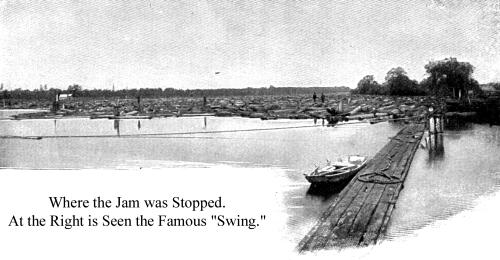 Other men were
equally busy hunting for piles. They took them where ever they
found them without attention to their owners. Farmer's trees were
cut out, and the farmers held at bay with peevies; pines belonging
to divers and protesting proprietors were felled and sharpened;
Holland and Muskegon furnished their quota by rail; even Uncle
Sam, the inviolable, was commandeered in a most cavalier fashion.
The D. & M. railroad company owned a fine lot of piles which,
with remarkable shortsightedness and lack of public spirit, they
refused to sell at any price. A crew of men took them by force.
Once, when other means failed, John Walsh was found up to his
waist in water, felling the trees of a wood, and dragging them
to the river by a cable attached to the winch of his driver. Other men were
equally busy hunting for piles. They took them where ever they
found them without attention to their owners. Farmer's trees were
cut out, and the farmers held at bay with peevies; pines belonging
to divers and protesting proprietors were felled and sharpened;
Holland and Muskegon furnished their quota by rail; even Uncle
Sam, the inviolable, was commandeered in a most cavalier fashion.
The D. & M. railroad company owned a fine lot of piles which,
with remarkable shortsightedness and lack of public spirit, they
refused to sell at any price. A crew of men took them by force.
Once, when other means failed, John Walsh was found up to his
waist in water, felling the trees of a wood, and dragging them
to the river by a cable attached to the winch of his driver.
And so, finally, for the second time, the auxiliary channel
was cleared. Gradually the pressure lightened. In three days more
the danger had passed. The impossible teas achieved.
All the rest of the summer was spent in the hardest kind of
work. The tangle had to be straightened; the logs which had been
carried inland a mile or more, to be restored to the river. All
must be sorted. Grand Rapids had to ship its cut back by railroad.
The Boom Company expended in all over sixty thousand dollars,
but it saved the community millions.
The men connected with this mighty crisis are to be found still
in western Michigan. The owners are wealthy business men; John
Walsh is considered the most reliable contractor in his town;
the seven members of No. 4's crew have risen to various posts
of responsibility afloat and ashore. And this again is characteristically
American. The fire that carried them through the weeks of the
"Big jam" was no momentary flicker; it has shone steadily
to guide them to success.
Logging Page
| Contents Page
|







